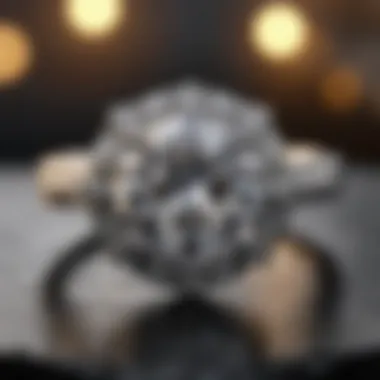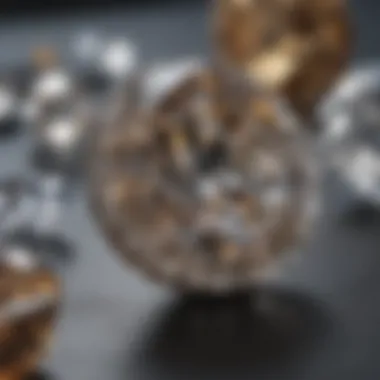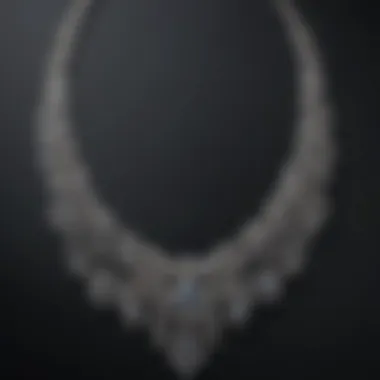Discovering Premier Diamond Jewellers for Quality Craftsmanship


Intro
The journey into the world of diamond jewellery begins with an understanding of the gems themselves. Diamonds are not merely stones; they carry a wealth of meaning, tradition, and craftsmanship. To identify the best jewellers, one must first appreciate what diamonds represent and how their attributes influence the market.
This article delves into the various factors that determine both the quality of a diamond and the reputation of those who craft them. From the intricacies of gemstone characteristics to the historical significance of diamonds in different cultures, the insights found here will guide readers in making informed decisions when purchasing diamond jewellery.
It is essential for consumers to seek jewellers who prioritize craftsmanship and ethical sourcing. We will explore these themes thoroughly, focusing on what distinguishes reputable jewellers from others in a crowded market. By the end, readers will be equipped not only with knowledge but also with an appreciation for the artistry and tradition that diamonds embody.
Understanding the Diamond Industry
The diamond industry is a multifaceted domain that encompasses various elements ranging from geological formation to market distribution. Understanding this industry is vital for those interested in purchasing or investing in diamonds. Knowledge of the industry not only helps consumers make informed choices but also deepens appreciation for the artistry and ethics behind diamond jewelry. Significant factors include the sourcing of diamonds, quality assurance, and trend awareness. Thus, this section lays the foundation for recognizing the broader implications of purchasing diamonds and the values associated with the brands that offer them.
The History of Diamonds
Diamonds have a long and rich history, dating back to their earliest known uses in ancient India. Initially, diamonds were valued for their strength and clarity, believed to possess protective properties. Over centuries, they transitioned from talismans to coveted gemstones for adornment, especially among royalty. As trade routes expanded, the diamond's allure spread to Europe, becoming synonymous with wealth and status.
In the 19th century, the discovery of diamond deposits in South Africa changed the landscape entirely. Companies formed, and the market for diamonds became more structured. The advent of mass marketing in the 20th century, particularly campaigns like "A Diamond is Forever" by De Beers, cemented the diamond's place in popular culture as the ultimate symbol of love. Understanding this historical trajectory provides important context for today’s market dynamics.
Key Players in the Market
The diamond industry comprises several key players that influence market dynamics significantly. Major mining companies such as De Beers and Alrosa dominate the supply landscape, controlling a substantial portion of global diamond production. These entities shape pricing structures and control distribution channels. In addition, there are retailers like Tiffany & Co. and Blue Nile that redefine consumer experiences by emphasizing quality and authenticity.
Jewelry designers also play a critical role; their unique perspectives and craftsmanship contribute to how diamonds are marketed and perceived. Emerging local boutiques are increasingly entering the scene, often focusing on customized experiences that cater to niche markets. Awareness of these players helps consumers navigate their choices effectively, from selection to purchase.
Market Trends and Consumer Preferences
The diamond market is subject to evolving trends and shifting preferences among consumers. In recent years, ethical sourcing has become more prominent, with buyers increasingly valuing traceability and responsible mining practices. Furthermore, there’s a marked rise in the popularity of lab-grown diamonds, driven by affordability and sustainability concerns. Consumers are more inclined to prioritize these factors when considering their purchases.
In addition, online shopping is growing, causing traditional retailers to adapt their strategies to include e-commerce avenues. The demand for unique and personalized designs is also rising, with many consumers seeking diamonds that tell a story. Monitoring these trends enables buyers to align their choices with their values and preferences, enhancing their purchasing experience.
In short, understanding the diamond industry is crucial. It informs consumer decisions while elevating the appreciation for craftsmanship and ethical practices prevailing in the market.
Criteria for Choosing a Jeweller
Choosing the right jeweller is a pivotal step in acquiring a diamond. A jeweller plays a significant role in not just the selection process, but also in ensuring the integrity and value of the purchase. Understanding the criteria for choosing a jeweller helps individuals make informed decisions that align with their preferences and values. This section focuses on vital elements, benefits, and considerations essential for selecting a jeweller who meets high standards in quality and service.
Reputation and Experience


A lawyer's reputation can heavily influence the buying experiene. An established jeweller often has a proven track record, showcasing consistency and quality. Consumers should look for client testimonials and reviews. Websites like Reddit or Facebook often provide user feedback, offering an unfiltered view of the jeweller's service. A jeweller's years in the industry is also a testament to their expertise. It reflects their ability to navigate the complexities of the market. Customers often feel more confident purchasing from someone experienced.
Quality Assurance and Certification
Quality assurance is vital when investing in a diamond. A reputable jeweller must provide certification for their diamonds. Certification from recognized authorities like the Gemological Institute of America (GIA) verifies the diamond's quality. Criteria such as cut, color, clarity, and carat weight should align with the certifcate details. Customers must demand transparency regarding these certifications. This not only supports the authenticity of the diamond but also enhances trust between the jeweller and the client.
Ethical Sourcing Practices
In today's market, ethical considerations increasingly influence purchasing decisions. Many consumers prioritize sustainability and ethical sourcing when selecting a jeweller. This means understanding whether the diamonds conflict-free, sourced from regions with no human rights abuses, and mined in environmentally responsible ways. Jewellers should be able to provide information on their sourcing practices. Knowing the source helps consumers feel more secure in their purchases, aligning them with values that respect both people and the planet.
Trusting a jeweller with a strong ethical commitment can enhance not only the purchase but also the overall value of the diamond.
Understanding these criteria ensures that buyers are equipped with tools to discern not just any jeweller, but the best one for their needs.
Spotlight on Renowned Jewellers
The landscape of diamond jewellery is populated with a range of establishments, some of which have earned reputations that transcend geographical boundaries. Spotlighting renowned jewellers is essential, as it not only informs consumers about high-quality options but also highlights craftsmanship, ethical sourcing practices, and overall shopping experience. Understanding what sets these jewellers apart is imperative for anyone looking to invest in diamond jewellery, as it fosters informed decision-making.
Flagship Stores to Consider
Flagship stores often serve as the main representation of a brand's commitment to quality. These establishments showcase the best that a jeweller has to offer. Not only do they exhibit a wide selection of diamonds but they also often provide an immersive experience that speaks volumes about the brand’s ethos. Stores such as Tiffany & Co. present a curated selection that reflects decades of craftsmanship and a keen eye for timeless design.
Factors to consider when visiting flagship stores include:
- Expertise: The staff is typically well-trained and knowledgeable, providing detailed descriptions of diamonds and settings.
- Environment: The ambiance of these stores is usually designed to enhance the shopping experience, making it luxurious and engaging.
- Exclusivity: Some flagship stores offer exclusive collections that may not be available elsewhere.
These elements come together to create a shopping experience that is both enjoyable and educational, providing clear insights into the artistry behind each piece.
Emerging Local Boutiques
Emerging local boutiques are often where creativity and personalized service converge. These smaller, often family-owned businesses may not have the vast resources of bigger brands but frequently offer unique selections that are reflective of local culture or artistic vision. Supporting these boutiques can provide benefits such as:
- Unique Designs: These shops tend to stock diamonds and settings that tell a story or exhibit local craftsmanship.
- Personalized Service: The intimacy of local boutiques means you often get better customer service, as the staff can dedicate more time to understanding your needs.
- Ethical Sourcing: Many local jewellers place an emphasis on ethically sourced stones, making them a socially responsible choice for conscientious buyers.
Customers who explore these options may find diamonds that resonate on a personal level while supporting small businesses.
Celebrity Endorsed Brands
Celebrity endorsements can play a significant role in shaping consumer perceptions in the diamond industry. Brands associated with well-known figures often carry a certain prestige, and the products typically feature elevated designs to match that image. Popular names such as Harry Winston and Cartier have been seen adorning red carpets, and their collections are known for stunning artistry. The benefits of considering these brands include:


- Trust Factor: Celebrity endorsement provides a level of assurance regarding quality and design standards.
- Innovative Design: Brands endorsed by celebrities usually continuously evolve their offerings to stay relevant, incorporating modern styles alongside traditional designs.
- Increased Visibility: The marketing backing that comes with celebrity brands can make it easier to find reputable information and reviews on products.
While it is essential to discern genuine artistry from mere marketing effort, many consumers find value and appeal in products from these celebrated brands. Familiarity with these names can influence purchasing decisions positively.
"Identifying renowned jewellers enhances the journey of selecting the perfect diamond, serving not only as a source of inspiration but also as a guide unto quality and ethical responsibility."
Evaluating Diamond Quality
Understanding how to evaluate diamond quality is critical for anyone interested in purchasing these gemstones. The quality of a diamond affects not just its aesthetic appeal, but also its value over time. In the competitive and variable market of diamond jewellery, comprehending how different elements contribute to quality can lead to more informed buying decisions. This understanding can also guide buyers toward jewellers who prioritize excellence and integrity in their offerings.
The Four Cs Explained
When it comes to evaluating diamond quality, the Four Cs serve as the foundational criteria: Cut, Clarity, Carat weight, and Color. Each of these factors contributes to the overall beauty and value of the diamond. Buyers must familiarize themselves with these criteria, as they are standard measures used across the industry.
- Cut: This refers not only to the shape of the diamond but also to how well it has been carved and polished. A well-cut diamond will reflect light beautifully.
- Clarity: This factor considers the number and visibility of blemishes and inclusions. A diamond with fewer of these will typically be more valuable.
- Carat Weight: This denotes the size of the diamond. Larger diamonds are generally rarer and more valuable.
- Color: This assesses the lack of color in a diamond. A colorless diamond usually holds more value than a colored one.
Understanding the Four Cs allows consumers to make educated comparisons between different diamonds and ensures they appreciate the intricacies of diamond selection.
Cut and its Impact
The cut of a diamond is arguably the most significant aspect influencing its radiance. A well-executed cut enhances the stone's ability to sparkle and dazzle. It refers to how well the facets, angles, and symmetry of the diamond have been designed and shaped. Poor cut quality can diminish a diamond’s brilliance, regardless of its clarity or carat weight.
Moreover, cut is the only characteristic influenced not by nature but by human craftsmanship. Excellent cuts can maximize the reflection of light internally and externally, creating that sought-after sparkle.
A diamond's cut is more than its shape; it influences light performance, which is key to its overall appeal.
Clarity and Its Significance
Clarity plays a vital role in determining a diamond's quality and value. It refers to the presence of imperfections within (inclusions) or on the surface (blemishes) of the stone. A diamond with high clarity will appear clearer and more appealing. Many buyers prefer diamonds that are graded higher on the clarity scale as they reflect light more effectively.
Factors affecting clarity include:
- Type of Inclusions: Some inclusions are more noticeable than others.
- Location: Inclusions closer to the surface can be more visible.
- Number of Inclusions: More inclusions generally reduce clarity.
Ultimately, understanding clarity is essential for buyers who wish to acquire a high-quality diamond that displays maximum brightness and beauty.
Shopping Experience Insights
Understanding the shopping experience is crucial when seeking the best diamond jewellers. This aspect goes beyond merely selecting a piece of jewellery; it encompasses the entire journey from discovery to ownership. A positive shopping experience is often characterized by knowledgeable staff, an enjoyable environment, and clarity in information provided. This ensures that buyers feel comfortable and informed about their choices. Additionally, how a jeweller operates can directly reflect their commitment to quality and customer satisfaction.


In-Store vs. Online Purchases
When it comes to purchasing diamonds, two primary options exist: in-store and online. Each avenue has its unique benefits and drawbacks.
In-Store Purchases
- Personal Interaction: Visiting a physical store allows customers to experience the jewellery firsthand. Customers can examine the diamonds under different lights, appreciate their brilliance, and ask immediate questions.
- Expert Guidance: Knowledgeable staff can provide insights into diamond qualities, aiding buyers in making informed choices. These professionals usually possess extensive training, which adds value to the buying process.
- Immediate Gratification: Buyers can leave the store with their purchase in hand, eliminating the need to wait for shipping.
Online Purchases
- Convenience: Shopping online provides flexibility in terms of time and location. Consumers can browse a wide selection from the comfort of home.
- Wider Selection: Online platforms often feature a broader range of jewelers and styles that may not be available locally.
- Price Comparisons: Prices can be easily compared across different websites, providing insight into the best deals and options.
Ultimately, the choice between in-store and online depends on personal preferences and comfort levels. Some consumers may prefer the tactile experience and personal guidance offered by physical jewellers, while others may value the convenience and selection found online.
Customer Service Considerations
Customer service is a key factor that significantly influences the shopping experience for diamond buyers. The quality of service can make the difference between a satisfactory and a poor purchasing decision.
Key Aspects
- Responsiveness: Jewellers should be approachable and responsive to inquiries, whether in-store or online. Quick replies indicate a commitment to customer satisfaction.
- Knowledgeable Staff: Staff should be well-trained, offering comprehensive information about diamond qualities, trends, and care. This enhances trust and assurance in the purchase.
- Return and Exchange Policies: Clear return policies are vital. Buyers should feel secure knowing that they can return or exchange their purchase if needed.
- Post-Purchase Support: After the sale, continued support is beneficial. Services like cleaning and maintenance can strengthen customer loyalty.
"A jeweller’s dedication to customer service is often reflected in the experiences shared by previous buyers. Positive reviews can be telling about how customers feel valued and respected."
Post-Purchase Considerations
The journey of acquiring a diamond does not conclude with the purchase. In fact, post-purchase considerations are crucial for safeguarding your investment and enhancing your experience. These considerations offer insights into how to protect your diamond, ensure its value over time, and maintain its pristine appearance. Understanding these facets can provide reassurance and elevate your overall satisfaction.
Insurance and Appraisals
Insurance for your diamond is more than a wise decision; it is a necessary step for any significant investment. Diamonds can be vulnerable to loss, damage, or theft. Hence, obtaining insurance can provide financial protection against unexpected events. It is advisable to conduct an appraisal to determine the value of your diamond. A reputable jeweller can offer this service or recommend a certified appraiser.
"Owning a diamond should be a joy, not a worry. Protect it wisely."
Appraisals are also essential for documentation. Should you decide to sell, upgrade, or insure your diamond, a certified appraisal will ensure you get a fair value, reflecting both its intrinsic qualities and current market conditions. Furthermore, keeping the appraisal updated is prudent as the value of diamonds can fluctuate based on market trends and economic factors.
Maintenance and Care of Diamonds
Caring for your diamond is vital to retaining its beauty and luster. Regular maintenance will prevent dirt and grime from dulling its brilliance. Proper cleaning is part of this process, and it is often recommended to clean the stone periodically using a gentle solution and a soft brush. Many jewellers provide cleaning services, which can ensure thoroughness and prevent damage.
When not worn, it is best to store your diamond in a separate compartment, ideally in a soft cloth or a dedicated jewelry box. This practice helps avoid scratches or damage caused by contact with other items.
Additionally, it's a good idea to have your diamond settings checked periodically. A loose stone can easily fall out, and securing the prongs can prevent loss. Most jewellers will provide inspections as part of their services, making it easy for you to maintain the integrity of your jewelry.
In summary, addressing post-purchase considerations such as insurance, appraisals, maintenance, and care is fundamental. These actions not only protect your investment but also enhance the enjoyment of your exquisite diamond.







